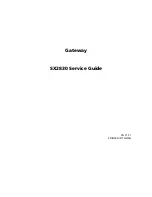
B-2
APX 1000™ Getting Started Guide
Slot Card Specifications
MultiDSP slot cards
indicate where and when the fault was detected.
If the indicator is in the flashing orange state before it goes green, a failure was detected during
the memory test or in the boot ROM on the slot card. If the indicator flashes once, pauses, and
then repeats, the failure occurred during the memory test. If the indicator flashes twice, pauses,
and then repeats, the boot ROM on the card failed.
If the indicator is in the flashing orange state after it has gone green, a failure was detected
during power-on self test (POST). The number of times the indicator flashes in rapid
succession before pausing and repeating the cycle indicates a POST failure code, from 1
through 27. The system also writes a log message, which provides a much easier mechanism
for determining the cause of the POST failure than counting the number of times the indicator
flashes.
MultiDSP slot cards
The MultiDSP is a 96-port digital signal processor slot card (APX8-SL-96DSP) for
terminating analog and digital calls received on channelized T1 or E1 lines.
The card is available in three models:
•
96-port model (APX8-SL-96DSP)
•
240-port model (APX-SL-DSP-3-L)
•
288-port model (APX-SL-DSP-3)
MultiDSP status indicator
All models of the MultiDSP slot card have the same front panel, which provides the status
indicator described in “Multipurpose status indicator on slot cards” on page B-1.
Figure B-1. MultiDSP cards
MultiDSP technical specifications
Table B-2 shows the technical specifications of the MultiDSP cards.
Table B-2. MultiDSP slot card specifications
Category
Specification
Physical interfaces
96 ports of supported application per 96-port MultiDSP card
240 ports of supported application per 240-port MultiDSP card
288 ports of supported application per 288-port MultiDSP card
Power requirements
37 watts, 7.4 amps for the 96-port MultiDSP card
48 watts, 9.6 amps for the 288-port MultiDSP card
Card weight
Approximately 1.5 pounds (0.7kg)
Hot swap capability
Yes
















































